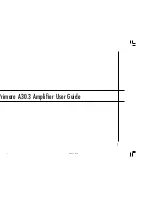
page 23
Reference Manual
IQ-PIP-USP3/CN
Enable:
Enables or disables this limiter.
Threshold:
Sets the average power level, in watts, which the limiter will allow from the
amplifier channel. The range is from 10 watts to 10,000 watts. This level should be set to the
connected loudspeaker’s long-term power rating.
Attack Time:
Sets the attack time of the limiter. The attack time is defined as the time it
takes the limiter to attenuate the output signal by 20 dB. The range is from 1 second to 30
seconds.
Release Time:
Sets the release time of the compressor. The release time is defined as the
time it takes the limiter to increase the output signal by 20 dB. The range is from 1 second to
30 seconds.
4.2.26 Clip Eliminator
This limiter monitors the clip events and attenuates the input signal to prevent amplifier
clipping. The attack and release times are preset to optimum rates. Only one parameter
controls this limiter.
Enable
enables or disables this limiter.
4.2.27 Thermal Limiter
This thermal limiter is provided to limit the amplifier output proportionally to available ther-
mal headroom, allowing smooth system level reduction while preventing amplifier overload.
Three parameters control this limiter for each channel:
Enable:
Enables or disables this limiter.
Threshold:
Sets the thermal level, in percent, above which the limiting will begin. The
range is from 1% to 100%.
Attenuation:
Sets the amount, in dB, that will be attenuated for each percentage point that
the thermal level exceeds the threshold. The range is from 0.5 dB to 6 dB in 0.5 dB steps.
4.2.28 Limiter Tie
This control forces both channels to track by using the greatest (worst case) attenuation of
any limiter from either channel. With this option disabled, each channel will independently
take the greatest attenuation of its own four limiters (voltage, power, clip, thermal) and
ignore the limiting of the other channel. Note that this function does not include the effects
of the input compressors. To tie the input compressors, use the Compressor Tie function.
4.2.29 Load Supervision
The load supervision feature allows real-time monitoring of the load connected to each
amplifier channel. When enabled, the IQ-PIP-USP3/CN continuously monitors the amplifier
output voltage and current, and calculates the long-term average load impedance. The mea-
sured load impedance is compared against the user-defined high and low limits. If either
limit is exceeded, the status indicator and, if enabled, the IQ System Error Reporting func-
tions alert the user of the problem. There are six controls and two indicators for each chan-
nel:
Enable:
Enables or disables the load-supervision function.
Содержание IQ-PIP-USP3
Страница 46: ...This page intentionally left blank ...
Страница 48: ......
















































